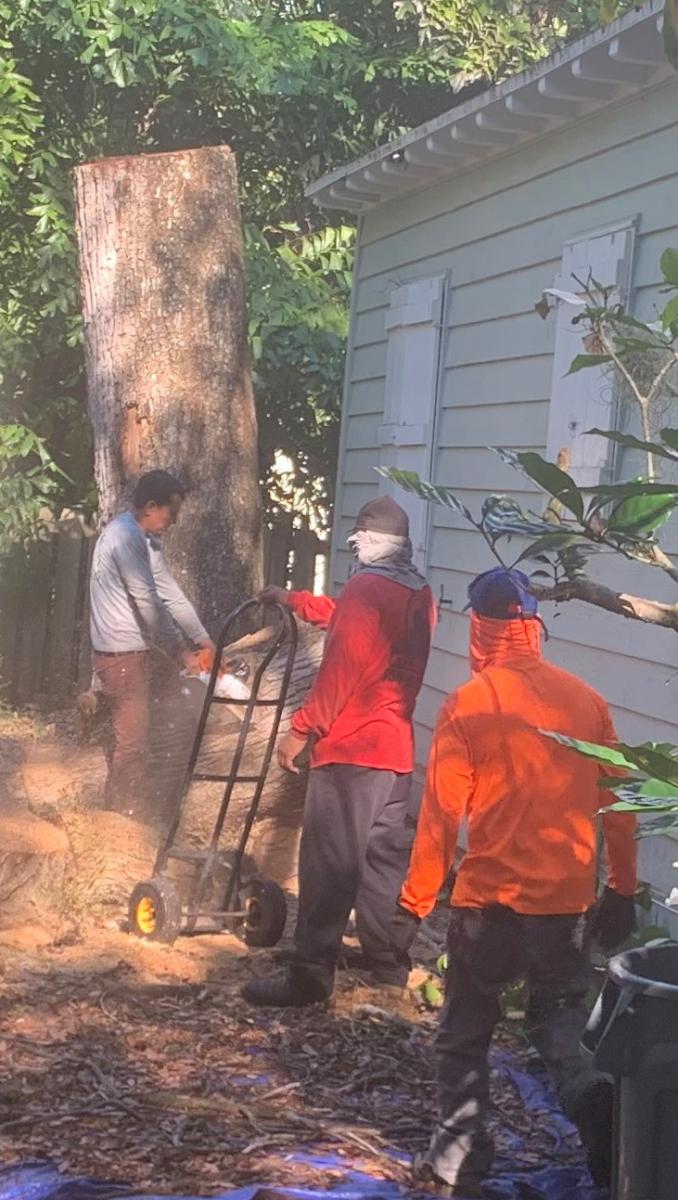Requiem For An Oak Tree

Our oak tree, in the late stages of the takedown
A neighbor noticed it first. The oak tree in the back of our house had a broad upper span, as 100-year-old oaks will. Its thick branches were extending over the rear of three neighboring properties, and the neighbor to the south noticed that a large branch over their home did not look healthy. The leaves were turning brown. It was a dead limb, and with hurricane season approaching, neither of us were anxious to see it break off and land on his roof. The rest of the tree seemed to be okay, but in the few weeks that it took to get a tree expert to look at it, other upper branches were also turning brown. The dead leaves were leaving the limbs bare. At first the tree guy thought we could just cut off a few dead branches, but by the time he was able to schedule the job, the whole tree seemed to be turning brown. And huge chunks of bark were now falling off the lower parts of the huge trunk.
"Lightning hit it," the tree guy decided. "When that happens, there's no way to save it."
Now this story does not rank in gravity with the situation in Afghanistan, or even the Covid pandemic. But in our neighborhood, the death of a vintage oak tree is not a trivial matter. In fact, Colee Hammock is named for the majestic oaks which line its streets and give the neighborhood a shaded charm that has few matches anywhere in the state. That beauty was obvious to the earliest developers of Fort Lauderdale. Mary Brickell, who owned the hammock in the late 1800s, took on one of the most powerful forces in the young state to preserve it. When Henry Flagler wanted to extend the Florida East Coast from Palm Beach to Miami, he wanted to keep it on a straight line on the high ridge where Florida's watery coastal strip gives way to more solid earth. That would bring the tracks through Colee Hammock.
But Mary Brickell insisted Flagler move his route west, away from her densely wooded hammock. Thus the sharp inland veer which takes the FEC tracks west and into downtown Fort Lauderdale. She had the foresight to preserve Colee Hammock for the shaded residential neighborhood it is today. It is more than a desirable place to live. Visitors enjoy walking several streets that are largely insulated from the heavy traffic to the beach on Las Olas Blvd. It is not unusual to see people pause to photograph the more striking homes, especially those with dense moss hanging from the oaks.
Thus it was with reluctance that we had to take our ailing tree down. It was not our first oak casualty. Over 50 years we have lost three others. One, maybe 50 years old, died in the middle of our front yard several decades ago. We replaced it with a tree that has grown about half as big as the original. Hurricane Wilma cost us two trees. One, very old, snapped about 10 feet up and landed on our roof. Fortunately the leafy branches cushioned the impact and we escaped with just a few holes to patch. The other was a younger tree in the back of the house, shading our deck, that was uprooted when the top half of a very old mango tree in the adjacent yard snapped and fell on it. Many younger oaks were uprooted by that storm and were propped back up. We wish now we had done that with our tree.
Preserving the character of Colee Hammock has not been easy. Most of the houses in the 1930s and 40s were built around the position of the trees. With a few exceptions, most of the homes were modest single-story cottages, designed to the scale of their lots. Inevitably some were neglected and became knockdowns. Most new construction, invariably much larger, has been respectful of the old trees, especially those which shade the streets. Increasingly, however, buyers are knocking down the old houses, even those in good shape, simply to make room for houses of several floors which take up the entire lots. This land usury has led to the disappearance of some apparently healthy old oaks under mysterious circumstances. There is a suspicion that some trees were poisoned to justify their removal and permit much larger homes than would otherwise be possible.
John Harris, whose firm Earth Advisors in Plantation is one of the country’s leading authorities on tree preservation, understands both sides of the story. An arborist and forester who also has a master’s degree in economics, he is a consultant to environmental groups, teaches a class on the subject, and writes a technical editorial for the Society of American Foresters. He sympathizes with those who want to protect old trees, but he also understands the problems Florida governments have in granting permits for tree removal, or enforcing vague regulations to protect neighborhoods such as Colee Hammock.
“Some of the oaks may be 200 years old or older,” he says, “and as they get older just as people they have health problems.” He says an arborist supporting a tree’s removal can find numerous hazards ranging from branches extending over a neighbor’s roof to trees whose surface roots constitute a tripping hazard. He says that roots sometimes affect water pipes, and when the roots are cut back, the tree can become unstable in severe weather.
“Public safety will always win,” he adds.
Florida’s problems are compounded by a state law passed and sponsored three years ago by legislators who had concerns about mitigation on their own properties to expand homes. Says Harris: “The law is deliberately written in such generic language that is so ambiguous that it makes it difficult for any city or county to decide if they have legal standing for code violations.” The result is that some old trees are obviously removed to make room for bigger houses that are determined by local laws governing the size of a building that can be built on a lot.
Further complicating matters is that not all arborists have Harris’ integrity. One element determining a permit for tree removal is a letter of support from a certified arborist. Some Colee Hammock residents think that all some arborists need to provide such a letter is a check that clears. And in fact, when it comes to 100-year-old oaks, almost all of them could be found to have potential hazards, such as our oak, whose decayed innards could not stand Wilma's gusts. This construction trend has resulted in a number of modern "box on a box" structures which are barely separated from and in fact dominate their older neighbors. Whereas the original houses had a cozy charm, some of the new construction has all the appeal of an Army reserve center. Longtime residents are upset and bewildered by new buyers who are drawn to the neighborhood because of its attractive canopy and then build monstrous homes that remove trees and destroy the very quality that attracted them in the first place.
Our late tree, because of its location, does not change the neighborhood's leafy character. Most only knew it was taken down by seeing the remnants lying in our swale waiting for pickup. Only the backs of adjacent houses were deprived of its shade. But a few days later I awoke in the middle of the night. The bed is close to a window, and when lying down one can see some sky. And in that sky was a strange yellow oval. For a second the thought of a UFO occurred, until the realization that this object was there all along, but the thick foliage of the tree had blocked its glow.
The object is called the moon.

The Old Oak Tree
This Comment had been Posted by Ted Drum
Bernie: Your article touched a spot in my heart. Carol and I lived for 40 years in an 1939 house on the "ridge" with 21' elevation, in Rio Vista. Lots of oaks and native trees to the ridge, like Gumbo Limbos. Prior to Carol passing away, we gave the house to our kids, for estate purposes . Some years after her death, I retained the rights to live in the house, rent free for 10 years, then I would have to pay market rent. I married Kathy Molinet (you probably knew Roland. ) She had a beautiful new house on the water, and as she reminded me, I no longer owned the old house. Plus our kids had lovely home on the water, so it had to be sold. Since it was a very big lot, there are now two new homes, not much charm, but nice large homes. Certainly not the old Rio Vista charm. All the old trees are gone. Since trees were very old, they all had some health challenges, somewhat like humans, when we get older, so they were all taken down. So I feel your pain. Ted
Death of an Oak Tree
This Comment had been Posted by Tom Flood
Sorry you lost one. We live in a community of oak trees. Visit any time. Love to Peggy